cabin power
greenheads
Registered Users Posts: 11 ✭
Good morning, im new to the site. we are constructing a small cabin (24x30) in Arkansas to be used mainly on the weekends and about 30 weekends a year. we will be completly off grid as the power stops about 4 miles from here. What i am looking to do is to supplement my energy with solar. as of now my plan is to use propane for cooking and heat. I have 2 generators, a honda eu 2000 and a generac 7500. I hope to not have to use the generac at all because it is loud. what i would like to do is use solar for my lights, tv and mini fridge and use my generator to sometimes run during the day and help recharge the batteries when needed.
my home tv and dish use 300 watts (I will use a smaller tv), total of 8 cfl's at 14 watts each will be installed. I have not purchased the mini fride yet so i am unsure of the energy usage but i would guess 150 start and 22 running.
I would like to run the mini fridge year round but the rest would only run when there. Can you help me with the calculations. thank you and have a great day.
my home tv and dish use 300 watts (I will use a smaller tv), total of 8 cfl's at 14 watts each will be installed. I have not purchased the mini fride yet so i am unsure of the energy usage but i would guess 150 start and 22 running.
I would like to run the mini fridge year round but the rest would only run when there. Can you help me with the calculations. thank you and have a great day.
Comments
-
Re: cabin power
Welcome to the forum greenheads.
Off Grid solar power is EXPENSIVE. And putting many thousands of dollars of equipment in a weekend cabin with questionable security is a risk in itself.
The first place we start is suggesting getting a Kill-a-Watt type power meter and measuring your loads (running the Honda for a couple of weekends would probably be more than enough).
What you will probably find is that ~1,000 Watt*Hours (1 kW) per day will give you enough power for some lighting, radio, small TV/laptop computer, cell phone charger and a small DC pump to pressurize your plumbing.
Add an electric refrigerator, and you are looking more towards 3.3 kWH per day... And it almost does not matter if it is a small "bar fridge" or an Energy Star rated full sized refrigerator (both use similar amounts of power). 3.3 kWH per day will be pretty much a near normal electric home/cabin (very conservation minded/energy efficient). There are "chest freezer conversions" that use much less power, but still need a good sized AC inverter+battery bank because of starting surges (DC refrigerators are nice, but many times, just too expensive to justify. "Cheaper" to get a good Energy Star fridge and up size the solar power system).
The problem with solar power is that it is really only cost effective when you use the cabin something near full time (like 9+ months a year).
When you are using it as a seasonal cabin, many times you are better off going with propane (such as a used propane fridge out of a scraped RV) and use solar+battery bank for a low power system (the 1 kWH per day system). The electric refrigerator and a deep well pump are the two devices that typically drive up the size/capabilities, and costs of your system. And running a refrigerator 365 days a year without needing a backup genset is probably not going to happen (week of bad weather, something fails on solar charging side, batteries go flat, food goes bad, and you are looking at a new battery bank and restocking the fridge/freezer). And even the 8x CFLs @ 14 watts each is a bit large... I would be looking at fewer bulbs and using lower powered LED type fixtures. Use spot light type lamps to light a workspace (kitchen table, reading lamp at chair, etc.) and avoid too many "flood"/room lights... 8*14watts*6hours-per-night=672WH per night--Already 70% of my proposed 1,000 WH per day power budget.
Figure that off grid solar will cost you around $1-$2 per kWH (even more for seasonal power usage) or over 10x the cost of your utility power--Conservation becomes the most important part of your power system design. It is almost always cheaper to conserve power than to generate it.
As you describe your place right now--I would go with a propane refrigerator or use the Honda eu2000i a couple times a day to keep a refrigerator/freezer cool enough for weekend use. And use a 1 kWH per day system and a small 300 watt AC sine wave 12 VDC input inverter for lights, radio, new LED TV, laptop, cell phone charger.
Lets start with a 1 kWH per day system for Little Rock Ark. First the batter bank (nominal/conservative system design--Will supply 1kWH per day for 7 day a week 9+ months a year usage without needed a genset except for bad weather/party weekends):- 1,000 WH per day * 1/0.85 AC inverter eff * 1/12 volt battery * 2 days of storage * 1/0.50 max batt discharge for longer life = 392 AH @ 12 volt battery bank
4x 6 volt @ 220 AH golf cart batteries will give you a cheap/rugged battery bank with 440 AH @ 12 volts of power.
To charge this bank, we need to size it to the battery bank with 5% to 13% rate of charge. In general, we suggest not "over-sizing" the battery bank. Instead, choose to spend your "extra money" in the solar array. 5% minimum rate of charge, but you will be happier long term with a 10% or larger solar array (longer battery life, a bit more power as yours loads/power usage grows over time).- 440 AH * 14.5 volt battery bank * 1/0.77 controller+panel derating * 0.05 rate of charge = 414 Watt array minimum
- 440 AH * 14.5 volt battery bank * 1/0.77 controller+panel derating * 0.10 rate of charge = 829 Watt array nominal
- 440 AH * 14.5 volt battery bank * 1/0.77 controller+panel derating * 0.13 rate of charge = 1,077 Watt array "cost effective" maximum
Month Solar Radiation (kWh/m 2/day) 1 3.78 2 4.38 3 5.19 4 5.67 5 5.89 6 5.81 7 5.93 8 6.08 9 5.41 10 5.16 11 3.69 12 3.56 Year 5.05
Dump the bottom 3 months (use generator for more than 2 days of bad weather), and we get February 4.28 hours of sun for your "break even" generator month:- 1,000 WH per day * 1/0.52 system eff * 1/4.28 hours of sun = 449 Watt array minimum (Feb "break even" month)
I would also suggest a battery monitor (Trimetric or Victron are good units). Add a good (not expensive) hydrometer, thermometer (to log temperature corrected specific gravity of your electrolyte) and a "cheap" DC Current Clamp DMM for maintenance/monitoring of your system.
If you decide you need a larger power system (refrigerator+), the math is the same, just 3.3 times larger. The battery bank would probably be a 24 or 48 volt version (and possibly larger, not golf cart, batteries).
Anyway--That is my first take at your needs.
Your thoughts?
-BillNear San Francisco California: 3.5kWatt Grid Tied Solar power system+small backup genset -
Re: cabin power
Look into LED lights. there are more coming to market all the time. I found some 2W (actual draw) 'chandelier' shaped lights in Costco, a 3 pack, I use them at home in the bedside reading lights.
KID #51B 4s 140W to 24V 900Ah C&D AGM
CL#29032 FW 2126/ 2073/ 2133 175A E-Panel WBjr, 3 x 4s 140W to 24V 900Ah C&D AGM
Cotek ST1500W 24V Inverter,OmniCharge 3024,
2 x Cisco WRT54GL i/c DD-WRT Rtr & Bridge,
Eu3/2/1000i Gens, 1680W & E-Panel/WBjr to come, CL #647 asleep
West Chilcotin, BC, Canada -
Re: cabin power
Thank you for the help so far, this definatly a little eye opening but i don't want to give up on it. Thank you for the help with the math, I think i will instead use LED's to help with the power consumption. The 8 bulbs i mentioned is all we will be installing and they shouldn't all be run at the same time so that will help a small amount. If i was guessing we will average 5 lights at 5 hours for 2 days a week. and for the tv it should average 5 hrs at 2 days a week. and can still run the EU2000 to charge the batteries at night if we use too much electricty.
I just looked into mini fridges and found this frigidaire 4.4 cu ft http://manuals.frigidaire.com/prodinfo_pdf/energyguides/FFPH44M4L_EG.PDF and it shows on the energy sticker that is uses 274kwh per year so about .75kwh per day. are these ratings very accurate?
BB do you think the system you used as an example would work with this? also i saw you mentioned that it is better to spend money on pannels vs. batteries, in your experience is a 2 day back up enough reserve capacity? Thank you again for your help i greatly appreciate it. -
Re: cabin power
Now days, the trade off favors a conventional fridge. That said, for weekends and occasional longer term use, consider a Lp fridge. It makes the app system smaller, but they are more expensive to buy (unless you buy a used one from an Rv wrecker for example) Adding 1kwh/day requires another ~500 watts of PV and battery just for the fridge.
Full time, go with a conventional and build the PV to suit. Part time, do the calc. When I last built my house, conventionals were 1-2 kwh/day, and LP was $1/gal, and APV was $8/watt. Nowadays, a fridge is .5-1kwh/day, propane is over $4 and PV is under $1, so more and more in favor of conventional.
When my batteries die, or my fridge dies, I will go conventional. Just as an FYI a large Lp fridge burns ~1500 BTUs/hour, with a duty cycle of perhaps 50%, so say 20k BTUs/day. A gallon of propane contains ~79,000 BTUs . You can do the math.
Good luck, and keep in touch,
Tony
PS Most mini fridges are terrible energy hogs, especially for thier size. By insulating the cabinets and adding fans on the condenser I cut my run time significantly on an LP fridge. -
Re: cabin power
I am on-grid-, so my suggestions are based on my calculations and what I read on the forum.
For example, that refrigerator you looked at was a 4.x cuft unit. I got a 16-17 cuft fridge from Home depot that was around 310 kWH per year.... Three to four times larger for a slight amount of increase in power usage.
Are the numbers accurate--if the area is not too hot, pretty good. If it is a hot summer climate, you are making ice, and placing warm food in Saturday, then the power usage can go up a lot.
If this is a cabin and you can live with just refrigeration, folks have converted a mid sized chest freezer into a chest refrigerator and will run on 250 WH per day typical (basically just change the thermostat to cycle at ~35F range instead of freezing).
Chest freezer as a chest refrigerator
The other problem is that a modern refrigerator (frost free) typically needs its AC power on 24x7 (defrost timer) and it needs a fairly hefty AC inverter to start the compressor (surge can easily exceed 600 VA). Pretty much you are usually looking at a minimum of 1,200 to 1,500 Watt AC inverter plus the losses of running the AC inverter 24 hours per day (480 WH per day just to run the AC inverter).
So, yes, you can probably probably up the system to ~2kWH per day sizing and run a refrigerator full time (and not much else). Or you can do a chest freezer conversion and maybe run at 1.5 kWH per day.
The two day a week thing is a bit tough... For various reasons, it does not really affect the size of the battery bank (in general, you need a minimum size bank to support your average loads and any heavy starting currents--the 2 days of storage and 50% maximum discharge really does give you a very capable system with room for aging, and hopefully 3-5 years typical of battery life---You don't want the battery bank collapsing after 1-2 years when the fridge starts, etc.).
You could cut back on the solar array size to the 5% rate of charge--Battery life may not be quite as good--But it does not matter as much because the batteries will probably "age out" before the "cycle out" on a weekend cabin. But the solar panels, these days, are about the cheapest part of the install. So saving some money on fewer panels at the expense of more gasoline use (say 1 gallon per weekend, 30 weekends, $4 per gallon, $120 worth of additional gasoline per year--Vs just buying $300 or so worth of "extra panels" at $1 per Watt... Pretty quick pay back and less generator hassles. Plus the system would support the occasional week or two trips too (with the extra solar panels).
Solar power is not cheap... The batteries are a major, repeating cost. The smaller the battery bank and the longer you can have them last, the better off you are (at least for out of pocket costs). 2 days is usually a good sweet spot for an off grid battery bank. Just use a reasonable sized backup genset (like the Honda eu2000i with a decent battery charger) and you are all set.
-BillNear San Francisco California: 3.5kWatt Grid Tied Solar power system+small backup genset -
Re: cabin powerNow days, the trade off favors a conventional fridge.
Very true. But under some circumstances it makes sense to use a DC fridge.
DC fridges can be more efficient than conventional fridges, but are more expensive. We usually suggest you buy a conventional fridge and buy a few more panels with the money you save. But that only makes sense if your system is large enough to run a conventional fridge.
If a conventional fridge is the only reason you are buying a large inverter, then you should consider a DC fridge. As BB. mentioned, an inverter large enough for a fridge will use about 480 watthours per day by just being turned on. My 8 cu ft DC fridge uses about 500 watthours per day.
--vtMaps4 X 235watt Samsung, Midnite ePanel, Outback VFX3524 FM60 & mate, 4 Interstate L16, trimetric, Honda eu2000i -
Re: cabin power
Good point, I have no knowledge of DC fridges so I don't have any basis to comment. I would add however that is is a really bad idea to use the DC (or AC for that matter) heating element of a absorption type fridge. It is hopelessly inefficient and typically doens't work very well.Very true. But under some circumstances it makes sense to use a DC fridge.
DC fridges can be more efficient than conventional fridges, but are more expensive. We usually suggest you buy a conventional fridge and buy a few more panels with the money you save. But that only makes sense if your system is large enough to run a conventional fridge.
If a conventional fridge is the only reason you are buying a large inverter, then you should consider a DC fridge. As BB. mentioned, an inverter large enough for a fridge will use about 480 watthours per day by just being turned on. My 8 cu ft DC fridge uses about 500 watthours per day.
--vtMaps
Tony -
Re: cabin power
Yep--We are talking about DC powered refrigeration pumps. Much more efficient than an absorption refrigerator (ammonia+heat).
http://www.danfoss.com/Products/Categories/Group/RA/Compressors/Direct-Current-Compressors/b44e7573-473b-4dba-90c2-431ffccf0b9c.html
The big problem is, usually, DC refrigerator/freezers tend to be a lot more expensive than their AC (high production volume) counterparts.
http://sundanzer.com/
http://www.sunfrost.com/
-BillNear San Francisco California: 3.5kWatt Grid Tied Solar power system+small backup genset -
Re: cabin powergreenheads wrote: »....... mentioned that it is better to spend money on pannels vs. batteries, in your experience is a 2 day back up enough reserve capacity? Thank you again for your help i greatly appreciate it.
with your occasional usage, you will seldom be stressing your batteries, and they will likely die of old age, before they hit their cycle life. So, I'd spend on panels, and minimal batteries, and in a couple years, upgrade the batteries. If you can look in the crystal ball, and see if you will end up with a 24V system, may as well buy a decent 24V inverter now, with a grid interface that will let it charge the batteries from the generator (at a high amp rate to reduce your generator run time)Powerfab top of pole PV mount | Listeroid 6/1 w/st5 gen head | XW6048 inverter/chgr | Iota 48V/15A charger | Morningstar 60A MPPT | 48V, 800A NiFe Battery (in series)| 15, Evergreen 205w "12V" PV array on pole | Midnight ePanel | Grundfos 10 SO5-9 with 3 wire Franklin Electric motor (1/2hp 240V 1ph ) on a timer for 3 hr noontime run - Runs off PV ||
|| Midnight Classic 200 | 10, Evergreen 200w in a 160VOC array ||
|| VEC1093 12V Charger | Maha C401 aa/aaa Charger | SureSine | Sunsaver MPPT 15A
solar: http://tinyurl.com/LMR-Solar
gen: http://tinyurl.com/LMR-Lister , -
Re: cabin power
For weekend use, a fridge will be pointless, as it takes about 12 - 24 hours to cool itself down. Block ice or dry ice till you get there full time. Or put in a large enough system to run the fridge 24/7 now.Powerfab top of pole PV mount | Listeroid 6/1 w/st5 gen head | XW6048 inverter/chgr | Iota 48V/15A charger | Morningstar 60A MPPT | 48V, 800A NiFe Battery (in series)| 15, Evergreen 205w "12V" PV array on pole | Midnight ePanel | Grundfos 10 SO5-9 with 3 wire Franklin Electric motor (1/2hp 240V 1ph ) on a timer for 3 hr noontime run - Runs off PV ||
|| Midnight Classic 200 | 10, Evergreen 200w in a 160VOC array ||
|| VEC1093 12V Charger | Maha C401 aa/aaa Charger | SureSine | Sunsaver MPPT 15A
solar: http://tinyurl.com/LMR-Solar
gen: http://tinyurl.com/LMR-Lister , -
Re: cabin power
It might ought be noted, that if you leave a fridge for a while, it is best to fill it up with mass, like water jugs.
Tony -
Re: cabin powerhttp://sundanzer.com/
-Bill
Wow! The power requirements of the DCR50 is quite attractive! -
Re: cabin powerWow! The power requirements of the DCR50 is quite attractive!
True, but at what cost compared to a "regular" energy star fridge, or efficiency and cost compared to a chest freezer conversion? And the cost of replacement when that's needed? Things to consider. It's less than 4 cu ft.
My 10 cu ft upright freezer converted to fridge uses an average of 10 watts, roughly the same consumption per cu ft as the SunDanzer.
For the 10 cu ft conversion, that's 240 watt hours per 24 hour day. That's less than the basic satellite receiver box, and if I remember correctly, cost around $600.00 Cdn. -
Re: cabin power
Hi I started with a lpg fridge, But was never really comfortable with a pilot flame running all the time. Then got a small Samsung fridge freezer consuming around 339 kw per year. (Energy star label) , Did some tests on the first 24 hours and subsequent days . The consumption was about what the label said for the first 24 hours then less by about 10% for the following days.
I have since upgraded to another Samsung fridge / freezer, 30% bigger but now using 319 kw per year. The new fridge is an inverter fridge and more efficient and quieter.
I use my holiday home predominately in the weekends, I find the fridge gets down to temp within an our or so.
Another advantage of a fridge freezer is that on returning home you have another set of freezer pads to put in your chilly bin when coming home after the weekend. So my advice would be start with an electric system.
Regards
Peter2225 wattts pv . Outback 2kw fxr pure sine inverter . fm80 charge controller . Mate 3. victron battery monitor . 24 volts in 2 volt Shoto lead carbon extreme batterys. off grid holiday home -
Re: cabin powerpetertearai wrote: »I have since upgraded to another Samsung fridge / freezer, 30% bigger but now using 319 kw per year. The new fridge is an inverter fridge and more efficient and quieter.
Regards
Peter
That sounds great. Can you supply the model # please? Very interested in specs on inverter fridges. -
Re: cabin powerwaynefromnscanada wrote: »Very interested in specs on inverter fridges.
So am I. Someone else posted a model number a couple of years ago. When I researched it, I found that they are not sold in the US market. Maybe in Canada?
--vtMaps
edit: here is one (panasonic) from a couple of years ago: http://forum.solar-electric.com/showthread.php?p=120105#post1201054 X 235watt Samsung, Midnite ePanel, Outback VFX3524 FM60 & mate, 4 Interstate L16, trimetric, Honda eu2000i -
Re: cabin power
He is in NZ, so it am not be available in the US or Canada,
Tony -
Re: cabin power
Hi Yes Im in NZ . Model is Model: SR340MW . Was on special $ 880.00 inc tax .2225 wattts pv . Outback 2kw fxr pure sine inverter . fm80 charge controller . Mate 3. victron battery monitor . 24 volts in 2 volt Shoto lead carbon extreme batterys. off grid holiday home -
Re: cabin power
317 kwh / year
http://www.samsung.com/au/consumer/home-appliances/refrigerator/top-freezer/RT32FARACWW/SA-spec -
Re: cabin powerwaynefromnscanada wrote: »
Good discussion. Inverter fridges could potentially transform the way small off grid systems are designed. I am interested in their soft start up capabilities. Anybody with an inverter fridge care to comment on this feature? Have you actually measured this on a KAW meter?Outback Flexpower 1 (FM80, VFX3048E-230v, Mate, FlexNetDC) 2,730watts of "Grid-type" PV, 370 AmpHrs Trojan RE-B's, Honda 2000 watt genny, 100% off grid. -
Re: cabin powerGood discussion. Inverter fridges could potentially transform the way small off grid systems are designed. I am interested in their soft start up capabilities. Anybody with an inverter fridge care to comment on this feature? Have you actually measured this on a KAW meter?
The (non-inverter) Whirlpool 18.1 cf fridge I bought 4 years ago is listed as 360kwh per year, actual measurements show it to be about 1.2kwh per day, however I am in Florida, and it is in non-air conditioned 85+ degree space so I would expect it to use more. Sure it has the surge but for $500 I am wondering if it would even be worth spending the extra $ for an inverter based one (other than the surge issue)?Off-Grid in Central Florida since 2005, Full-Time since June 2014 | 12 X Sovello 205w panels, 9 X ToPoint 220w panels, 36x ToPoint 225w panels (12,525 watts total) | Custom built single-axis ground mounts | Complete FP2 Outback System: 3 x FM80, 2 x VFX3648, X240 Transformer, FLEXnet-DC, Mate-3, Hub-10, FW500 AC/DC | 24 x Trojan L16RE-B Batteries 1110ah @ 48v | Honda EU7000is Generator and a pile of "other" Generators | Home-Made PVC solar hot water collector | Custom data logging software http://www.somewhatcrookedcamp.com/monitormate.html -
Re: cabin powerSure it has the surge but for $500 I am wondering if it would even be worth spending the extra $ for an inverter based one (other than the surge issue)?
Probably not. If your system and inverter are large enough to handle the surge, then it doesn't matter. If the only reason you are running a large inverter is because of the surge, then it makes sense to use a smaller inverter and an inverter fridge.
Note: an inverter fridge may have a proportional drive compressor. This may give an overall slight improvement in efficiency. In other words, it may be more efficient to run a compressor continuously at half speed, rather than at full speed for half the time.
btw, the DC fridges with a Danfoss compressor have proportional drive compressors.
--vtMaps4 X 235watt Samsung, Midnite ePanel, Outback VFX3524 FM60 & mate, 4 Interstate L16, trimetric, Honda eu2000i -
Re: cabin power
Bill, the link for the write up in the first post of that thread is no longer valid.
I found it here, though: http://mtbest.net/chest_fridge_1.pdf
Perhaps, one of you staff folks may change it in that post?Paul -
Re: cabin power
Thank you ILFE, I have updated the post.
-BillNear San Francisco California: 3.5kWatt Grid Tied Solar power system+small backup genset -
Re: cabin power
We have installed Direct Current Compressors • Solar Applications • 10-45V DC for our customers who have big trailers for racing weekends. We do the refrigeration side of it and they power system up so we can charge refrigerant into fridge and freezer. Look under the Danfoss brand.4-Canadian Solar CS330 in series/TraceSW4024/Midnite Classic 250 with Whiz Bang jr/8 L16-370ah 4S2P/ Propane Honda EU2000/Propane Champion3800/electric refrig/Wood heat/Propane tankless water heater/ Grundfos SQE well pump. adding 6 REC Twin Peak 350 watt panels
Off grid in Upper peninsula Michigan -
Re: cabin power
So looks like not for sale in America or Canada?
Sorry 317 kw not 319 kw .
I haven't checked this fridge with kwh meter but Dont think my $25-00 unit is capable of reporting the surge current. Maybe my dc clamp tester can capture the surge start current. From the literature about the inverter fridges it seems the slowing down of the compressor is where most of the energy saving is obtained.2225 wattts pv . Outback 2kw fxr pure sine inverter . fm80 charge controller . Mate 3. victron battery monitor . 24 volts in 2 volt Shoto lead carbon extreme batterys. off grid holiday home -
Re: cabin powerpetertearai wrote: »So looks like not for sale in America or Canada?
Sorry 317 kw not 319 kw .
I haven't checked this fridge with kwh meter but Dont think my $25-00 unit is capable of reporting the surge current. Maybe my dc clamp tester can capture the surge start current. From the literature about the inverter fridges it seems the slowing down of the compressor is where most of the energy saving is obtained.
My clamp on ammeter has an option to hold the current reading. If a higher reading is detected, it will capture and hold that one. I'm not sure if they all do that, though?Paul -
Re: cabin power
You have to have a meter designed for "peak hold" function... They are out there, and there are some that are not $400 Fluke meters.
-BillNear San Francisco California: 3.5kWatt Grid Tied Solar power system+small backup genset -
Re: cabin power
I have a 12 x 32 Cabin in Southern Ohio I finished last year. Totally off grid. I went back and forth about putting in an LP fridge or just using an ice chest with ice. I decided to try the ice chest route for year or so and if it was a pain I'd get an LP fridge. Well, I was pretty happy with the ice chest filled with ice from the ice maker in our house. Two large Ziplocs full of cubed ice would keep everything cold (was cold from the fridge first) for the entire weekend and I had clean ice for drinks from Ziploc's whenever I wanted too. It was nice not having to unload then reload the an ice chest every time we got there and left too. It all stayed in the ice chest for the entire trip.
I have a wood burning stove for heat and I almost always have a pot of water on it to moisten the air and to use for cleaning dishes. I bought a used RV stove/oven and dropped it the counter for cooking and have an instant on propane water heater for showers and such. 12V RV water pump for water to the sink and outside the shower/spigot.
Pic's are when it wasn't quite done yet, but almost.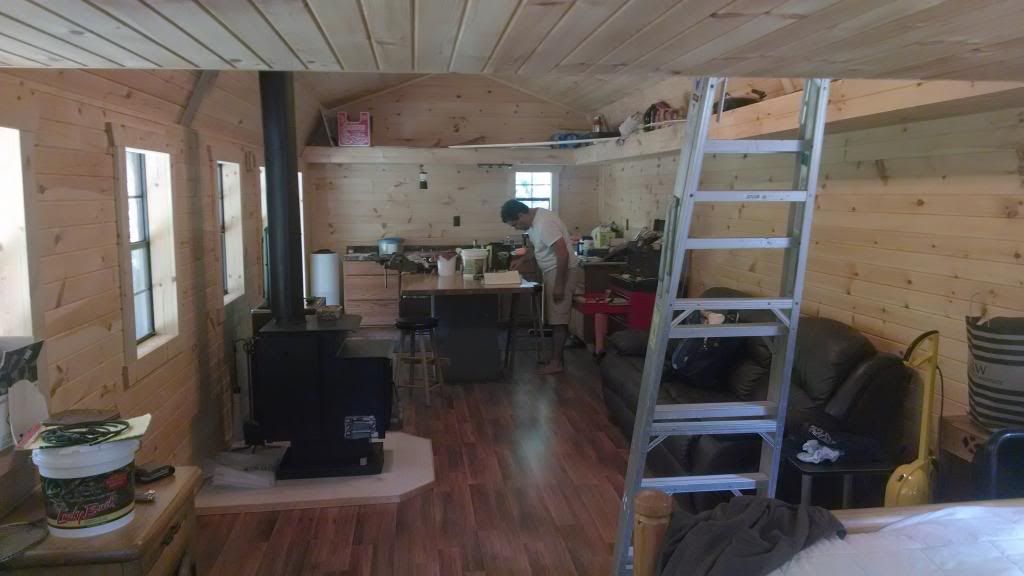
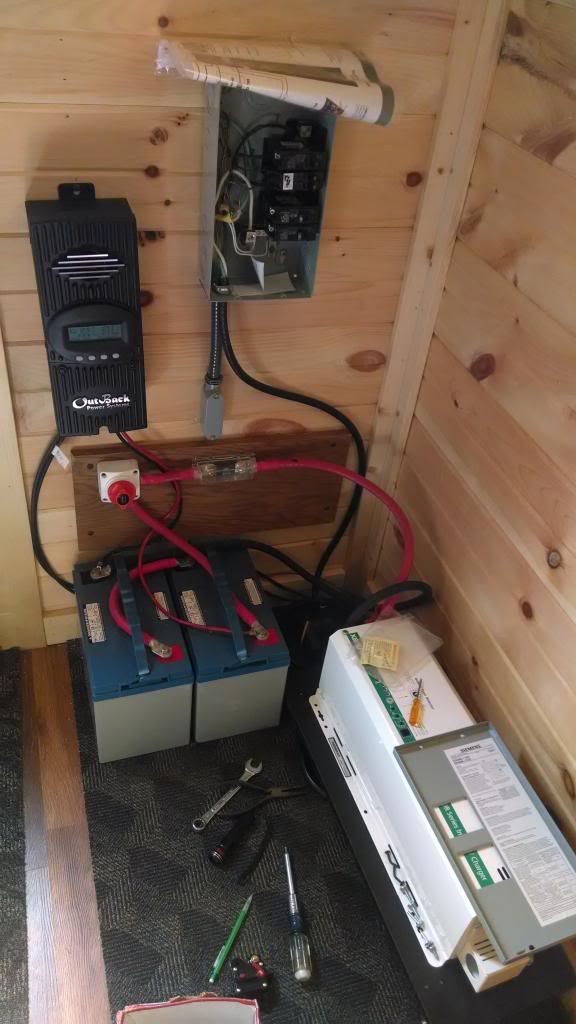
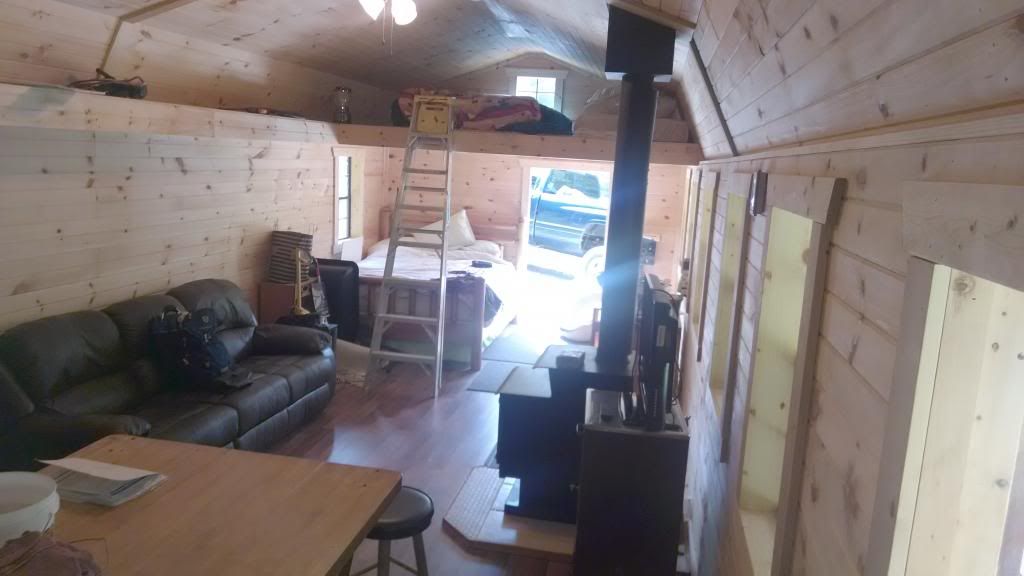
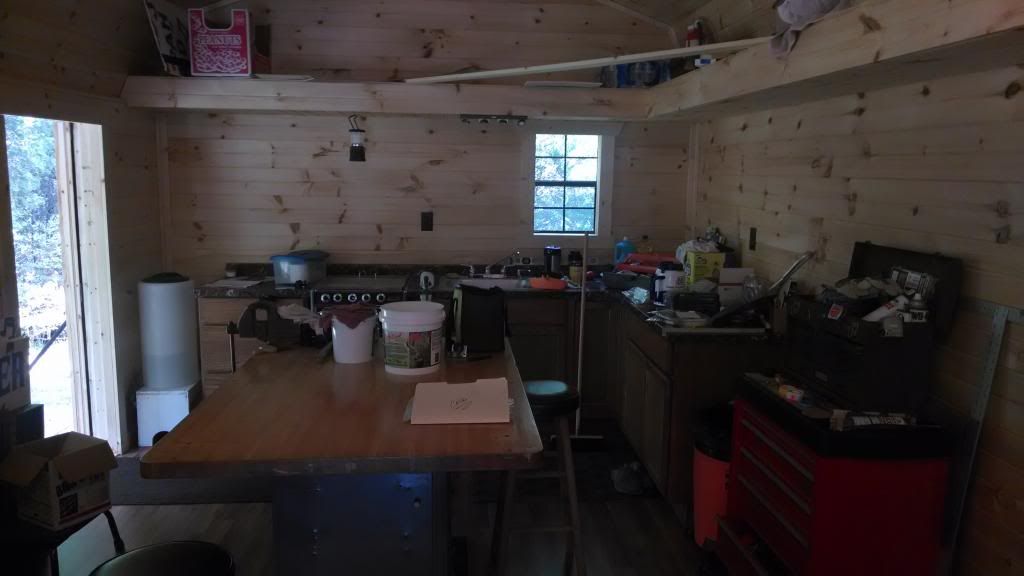
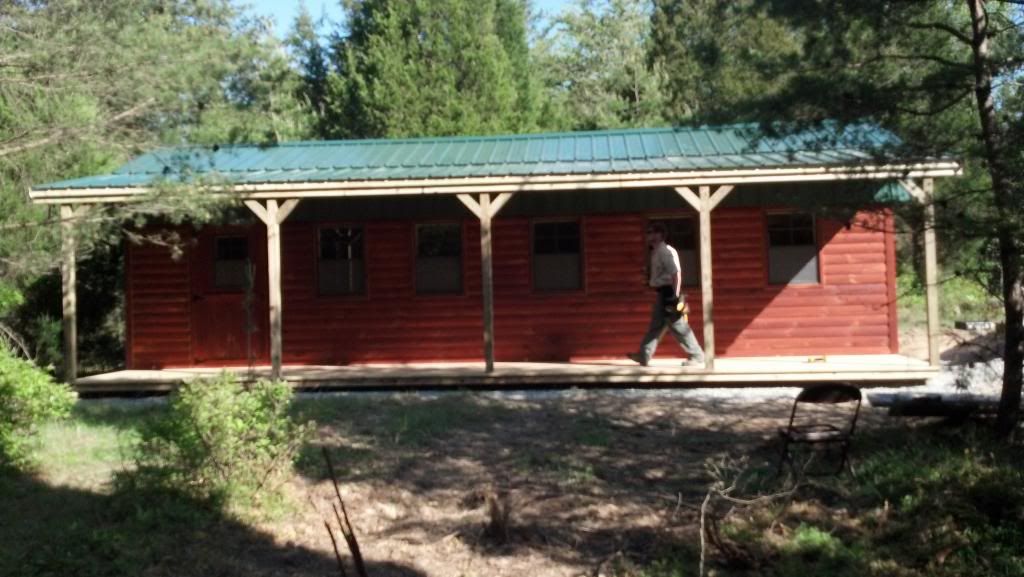
-
Re: cabin power
Most of the discussion is on the fridge, but take a look at Nokero and dLight rechargeable lamps. I use 5 of them in our on-grid house, with 2 over the computer desk. They provide all the light needed for most normal use.
Categories
- All Categories
- 233 Forum & Website
- 141 Solar Forum News and Announcements
- 1.4K Solar News, Reviews, & Product Announcements
- 199 Solar Information links & sources, event announcements
- 900 Solar Product Reviews & Opinions
- 256 Solar Skeptics, Hype, & Scams Corner
- 22.5K Solar Electric Power, Wind Power & Balance of System
- 3.5K General Solar Power Topics
- 6.7K Solar Beginners Corner
- 1K PV Installers Forum - NEC, Wiring, Installation
- 2.1K Advanced Solar Electric Technical Forum
- 5.6K Off Grid Solar & Battery Systems
- 429 Caravan, Recreational Vehicle, and Marine Power Systems
- 1.1K Grid Tie and Grid Interactive Systems
- 656 Solar Water Pumping
- 816 Wind Power Generation
- 624 Energy Use & Conservation
- 623 Discussion Forums/Café
- 315 In the Weeds--Member's Choice
- 75 Construction
- 125 New Battery Technologies
- 108 Old Battery Tech Discussions
- 3.8K Solar News - Automatic Feed
- 3.8K Solar Energy News RSS Feed
